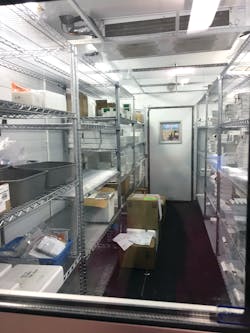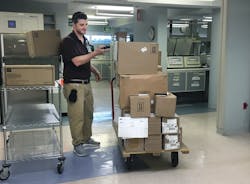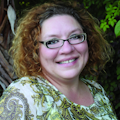The MLO editors enthusiastically visited Sarasota Memorial Hospital (SMH) for the second time this year to highlight our local clinical laboratory’s utilization of supplies. We knew prior to our arrival that the SMH lab did not utilize an electronic inventory system. Seeing as they had just implemented a very sophisticated automation system (see our article entitled, SMH lab techs talk automation in MLO’s March 2019 issue), the fact that they were manually controlling their inventory piqued our interest even more. Questions like, how do they manage? (just fine, as you will read below); why not electronic? (not possible without a capital request); and who was responsible? The latter question was quickly answered as we were greeted with a platter full of chocolate chip cookies and a conference room filled with seven key staff members—many of who are very seasoned, and all of who are responsible for the lab’s inventory.
Now let’s get down to business.
Who is responsible for ordering lab supplies?
Each one of the seven employees we interviewed indicated they were responsible for ordering lab supplies for their department through their hospital-wide software program. SMH is large, measuring 21,500 square feet in their central laboratory. (This does not include Histology whose services are performed by their Pathology Group as an external contract service.) They employ 130 FTE’s, which equates to about 150 individuals (as not all staff are full time).
How do you ensure the ordered supplies are being utilized correctly?
It appeared communication was the most effective way to find out if supplies are being utilized correctly.
A bold employee responded, “I ask! I don’t give out supplies unless the blood is coming back to us. A lot of (local) doctor’s offices use us at their primary lab. I don’t want to provide tubes that are going to Quest or LabCorp, so I tell them that upfront. Everyone is receptive of this and it goes well, for the most part.”
What’s an example of supply misuse that you’ve encountered?
A senior MT quickly chimed, “Wasting something! Let’s just say … that the wash solution in the urinalysis department is getting low. The analyzers will tell you when it is getting low and when to change it. But there’s some folks in the world who don’t want to wait for that, and they’ll change it early. The problem is that the analyzer knows when it needs to be changed, it’s all gauged on sensors. If you’re changing it too often, there’s where your waste comes in and it can make my numbers fluctuate. However, when I took over the role of inventory for supplies in the urinalysis department, it was clear that we should let the analyzer tell us when to change it and now new employees have this incorporated into their training process. I have very little waste.”
Expired product was also an example of wasted supplies. To avoid this, another MT stated, “Supplies are dated when they come in. The new ones go to the back, so you have no choice but to use what’s going to expire first.”
In regard to expiration we were told controls and very unique tests tended to be the supplies that expired before use. However, we were assured expired products were always disposed of properly. The same dynamic exists with their blood tubes. Once the tubes leave the facility, a dedicated person tracks the expiration dates, so the lab isn’t receiving expired tubes to do testing on.
What’s the biggest challenge/hardest part of your job regarding inventory control?
One MT said, “Probably communication—that people are really letting you know when things are getting low. I really try to stay on top of it, so I don’t have a problem with that, but I see it happen in other areas.”
“I don’t seem to have any problems! I click the (computer) mouse; it takes me two seconds,” said another MT. A simple task, she confessed, for when she can’t get off the bench.
Another MT said, “My biggest thing is probably when I give a doctor’s office a tray of tubes and they let them expire. I get a little upset about that. There’s nothing we can do so I adjust by not giving them a full tray the next time and letting them know.”
“Same problem with some nursing floors; somebody will stock their cart and the other half (of the supplies) will be found six months later in a cabinet,” summed up another.
Needless to say, lack of communication between your peers can be a challenge—regardless of what industry you’re in!
How do you improve communication?
Similar to many other industries, our group of interviewees agreed meetings were not the best way to communicate. Instead, face-to-face conversations and/or emails were the preferred choice for improving communication.
“Rounding with nurse educators, MSTs, and PCTs—the people that collect the specimens—let them know to keep an eye on them and ensure they get used in a timely manner," said one MT.
As per another, “When we get the new batches of reagents, we have different lot numbers which require calibration. We communicate by email and for the new supplies that are not calibrated yet, we put a big note with red stickers on the lab supplies that signifies they haven’t been calibrated and are part of a new lot.”
Retrieving the wrong product is an obvious concern.
Another MT responded, “When you’re in a hurry, like in a STAT situation, and you run out of something, people grab things unknowingly. Analyzers know something doesn’t belong because it’s been bar coded. However, urine strips don’t work like that.”
Another stated, “I’m always adjusting to ensure that things are foolproof.”
“I can’t remember the last time we ran out of something,” said another.
What happens when you do run out of things?
Having a good relationship both internally and externally is important, which was confirmed by Dana Rickard, SMH’s Laboratory Operations Manager. “We can borrow from other facilities. Or have it shipped overnight; however, that can affect budget. We have a good rapport with local hospitals to borrow.”
How much pressure do you feel from corporate to keep the budget down?
As per Dana, “We’re busy, so we’re not getting a lot of pushback. Obviously if we have patients, we need supplies. When we’re buying stuff, we aren’t buying it for it to sit around, we’re buying it because we need it for patient care. If we’re getting new supplies, we’re always looking at vendors who can give it to us at the best price.”
Who is responsible for looking at different suppliers and/or vendors?
According to Dana, “We have several different ways. We have contracts with outside companies through a buying group. We also look at all the major vendors and evaluate based on what our needs are. We make sure we’re getting what is best for our patients, not the cheapest. This is a major component of my job and our laboratorians who work on the floor’s job. Group buy-in is important!”
Dana raised her arm for all to see, “I’m actually evaluating a unique arm band right now for patients that receive blood, since our contract is up with our (current) vendor. Seeing how long they last on your arm, whether they are waterproof, evaluating them, etc.” She reiterated that just because the group likes a product doesn’t guarantee they’ll purchase it. In the end they select what’s best for the patient.
Can you tell us about your inventory/storage?
We learned SMH lab has a huge off-site supply warehouse (think Walmart) where stock supplies (both refrigerated and non-) can be ordered and received the next day. The warehouse supplies SMH, Lee Memorial Hospital in Fort Myers and a few other hospitals that are part of the conglomerate.
We also learned the lab’s purchasing group has a supply room downstairs that has a bar coding system so inventory can be tracked. However, based on the fact that the lab orders the majority of their own supplies and regularly receives standing orders, it’s mostly used when they need to supplement.
Keeping their pulse on their coworkers’ vacation and holiday schedules was also a tactic used for monitoring supplies. Also, to be watched? Mother Nature! Ordering ahead of time eliminates last minute stress due to weather emergencies.
Speaking of weather, tell us about emergency prep; specifically, Hurricane Irma.
Dana stated, “We ordered supplies when we knew the hurricane was coming but all the major carriers wouldn’t bring their trucks into Florida. We had supplies that we couldn’t get to because they were stuck in FedEx warehouses in Tampa and Orlando; they weren’t coming down into the state any farther.”
Hurricane Irma triggered the largest mass evacuation in U.S. history. More than 7 million people in Florida, Georgia, and South Carolina were issued a mix of mandatory and voluntary evacuation orders as the Category 5 storm barreled toward Florida. Sarasota County, including SMH, was affected.
“We managed through! We were worried about the reagents; like, would they stay refrigerated? It was stressful because we didn’t know how much damage there would be,” shared another.
How much time is spent reconciling usage?
“All the time! We are always looking at it. We are growing right now so we’re constantly reevaluating our inventory; if we see a downtick in things it shifts our orders; our standing order will be reduced a little bit; and we’ve had to do that with the coagulation supplies over the years. Things change; we quit doing this test as much as that test, etc.,” said Dana.
“Based on the numbers this year, we will likely all bump up our standing orders,” assured another.
Why is controlling inventory important to the laboratory’s success?
An enthusiastic response came almost immediately: “It’s good patient care! We have to! We have a big outreach department. I have to have urinalysis supplies. It’s the number one ordered test in the lab,” said the urinalysis MT. Another chimed in, “No reagents, no tests!”
Besides communication, what other suggestions/tips do you have for your peers/MLO readers?
As per Dana, “We have a system! It’s been ingrained in all of us. If you’re at home and down to the last bit of milk, you’re going to make sure you’re going to get more. Don’t wait until you are down to the last kit! And rotation! Stay on top of things!”
Linda said, “It took me a while to set it up in the computer and sit and work with the numbers and go by the percentages annually but once I did, I actually really do enjoy it. I look at it regularly to make sure we’re not out of things. It’s challenging for me but also an enjoyment! And if I go on vacation, I rely on my colleague; we try to do the same for each other.”
Felix commented, “I’m very happy to share the responsibility; but it’s part of the job description for EVERYBODY!”
The entire group concurred.
We know you don’t have an electronic inventory system—but is there one in the pipeline?
Dana replied, “We looked at one; we wanted to piggyback off of the one downstairs in the supply chain; but we had to have wands and things we weren’t ready for yet … it wasn’t going to be cost effective at the time. We haven’t revisited it yet; patient care comes first. We manage pretty well. We have some awesome peeps!”
Many thanks to the stellar SMH laboratory team who participated in our on-site interview:
- Dana Rickard: Laboratory Operations Manager
- Felix Machuca: MT, Hematology and Coagulation
- Sandy Erickson: MT, Chemistry
- Linda Bowen: MT, Urinalysis
- Mark Durfee: PreAnalytical Lab Supervisor, 1st shift, Phlebotomy
- Dawn Wilson: Customer Service Representative
- Jaime Kennedy: Administrative Assistant




